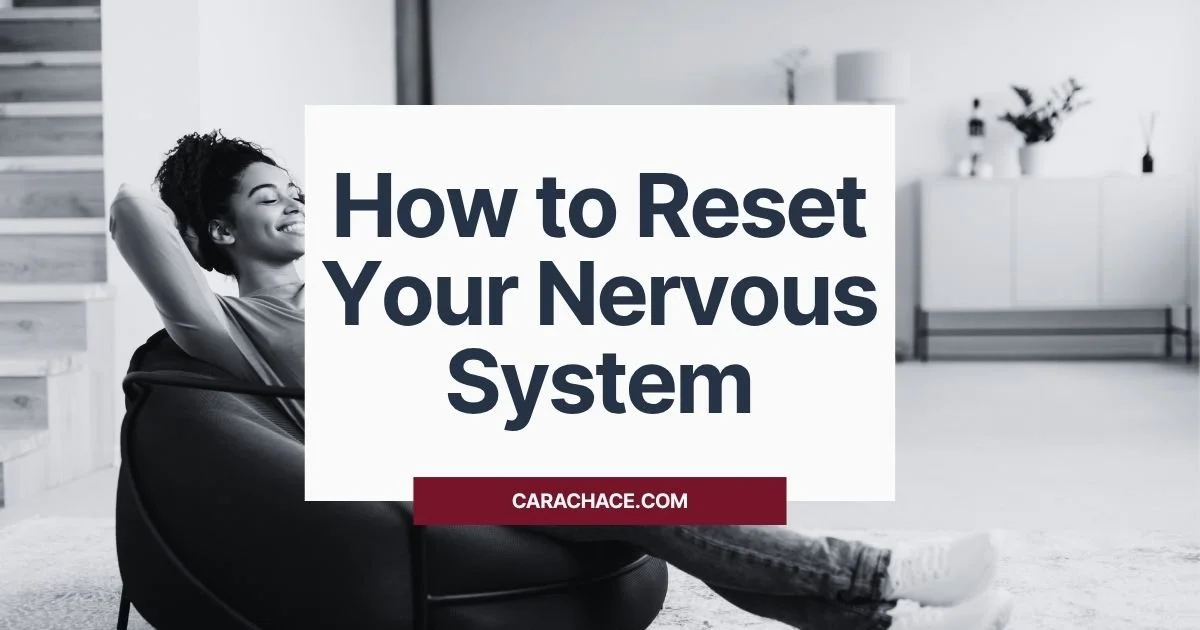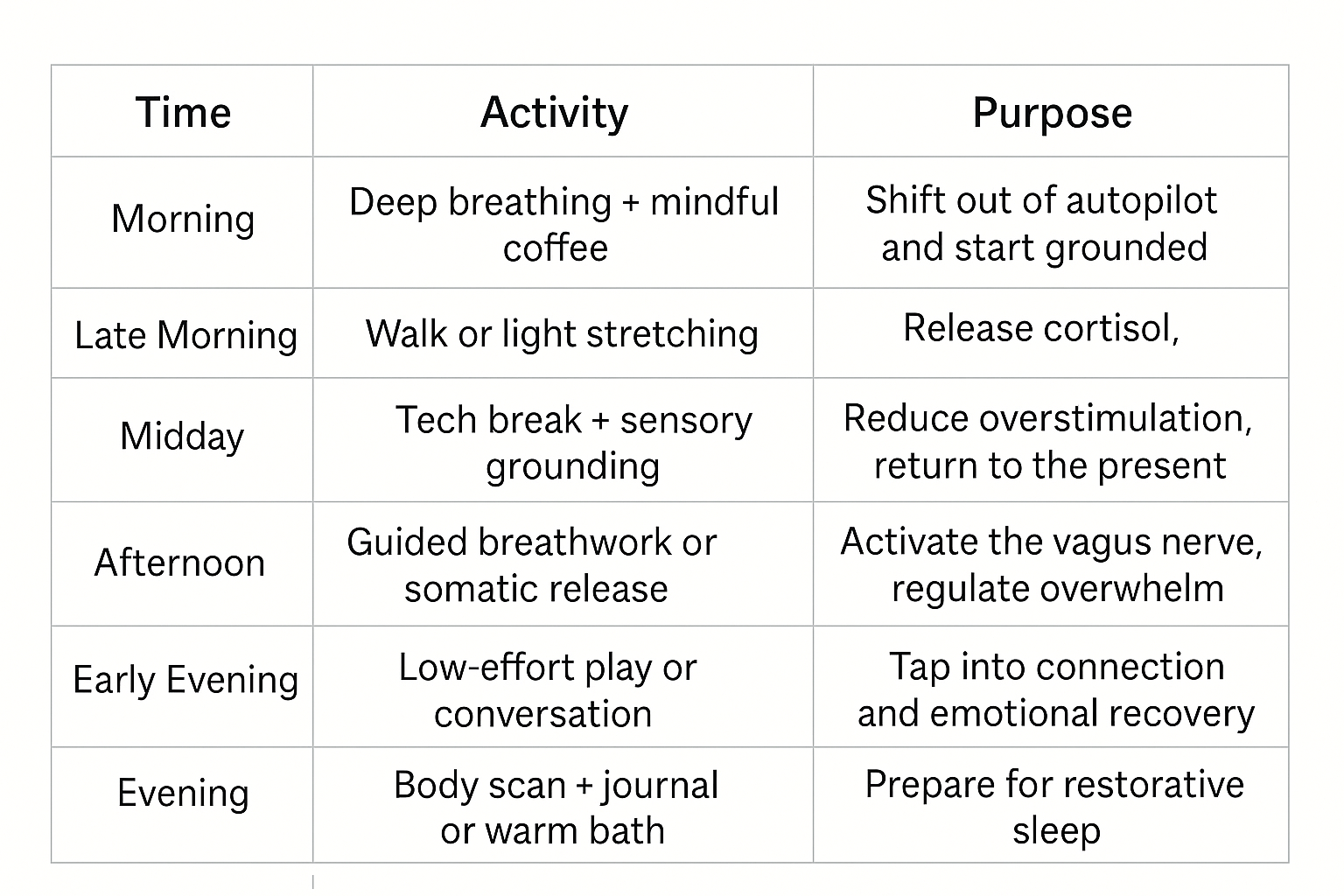How to Reset Your Nervous System: Effective Stress Relief and Calming Techniques
A nervous system reset isn’t self-care fluff or another “wellness trend” to add to your overflowing to-do list. It’s a functional strategy to calm your body’s internal alarms when stress has been running the show for too long. And if you’re a high-achieving, overwhelmed woman juggling unpredictable days and constant mental load—you need this more than another productivity hack.
At its core, a nervous system reset is about shifting out of survival mode. It’s a deliberate pause that gives your brain and body a chance to downshift from chronic tension into calm. Think of it as clearing static so your focus, energy, and emotional regulation can come back online.
The best part? This reset doesn’t require a retreat or a silent room (although that’s nice!). You can design it to fit your real life: a dedicated reset day, a 20-minute block between meetings, or a 60-second pause before you dive into your inbox. The scale is flexible—the impact isn’t.
What a Nervous System Reset Actually Means
Your nervous system has two main modes: survival and safety. When you're in fight, flight, or freeze mode, your sympathetic nervous system is active—pumping stress hormones, tightening your muscles, and shortening your breath. This response is useful in emergencies. But for many women, especially those balancing work, family, and expectations, this state becomes the default.
Chronic dysregulation doesn’t always show up as panic. It often looks like:
Snapping at small things because your fuse is short
Lying awake despite being exhausted
Feeling overstimulated, even from normal tasks
Constant background anxiety that you can’t shake
Being “productive” all day but still ending it drained
When your system doesn’t get a chance to reset, the effects compound. Your focus suffers. Your sleep quality drops. Your ability to make calm decisions evaporates. And your baseline becomes survival—not clarity.
Resetting your nervous system reactivates your parasympathetic state—the one responsible for rest, digestion, and recovery. When you engage this system, you create space for resilience, emotional regulation, and actual rest that restores you instead of just numbing the stress.
Step-by-Step Nervous System Reset Day
A full nervous system reset day isn’t about checking boxes—it’s about creating space to interrupt chronic stress and reconnect with calm. If you’re used to over-scheduling yourself and doom-scrolling as avoidance, this might feel uncomfortable at first. That’s the point. This is structured unscheduling: time blocked for downshifting, not doing.
Here’s a sample step-by-step nervous system reset day you can customize based on your energy, responsibilities, and environment:
Each activity is chosen for its ability to cue safety and regulation—not stimulation or output. You’re training your system to trust that it doesn’t have to stay on high alert to be productive.
Simple Ways to Relax Your Nervous System at Home
A full day isn’t always possible—and that doesn’t mean you’re stuck in burnout. Nervous system care can happen in short bursts. The goal is consistency, not intensity.
Here are flexible options for resets that meet you where you are:
1-Hour Reset
10 minutes of breathwork (physiological sigh or box breathing)
30-minute walk outdoors or slow yoga
10-minute screen break + grounding tea or aromatherapy
10-minute journaling or body scan
15-Minute Reset
3-minute breathing reset (long exhales)
5-minute stretch or shake-out
7 minutes of no-scroll stillness: music, nature, or mindful silence
60-Second Micro-Reset
One deep inhale + long exhale
Humming or vagus nerve activation (splash cold water, gentle neck stretch)
Name 3 things you see, hear, and feel to orient back to now
These aren’t extras. They’re system stabilizers. Stack them when you can—but don’t wait for perfect conditions. Regulation is built in the pauses, not the plans.
Best Practices for a Daily Nervous System Reset Routine
Regulation isn’t a one-time event. The women who thrive long term—without burning out—have one thing in common: consistency. A daily nervous system reset routine creates anchor points throughout your day to keep your baseline steady, even when life isn’t.
Here are three simple practices to turn regulation into a low-maintenance habit:
1. Digital Boundaries That Protect Your Focus
Your nervous system isn’t built to absorb nonstop alerts and scroll loops. Set non-negotiable screen-free windows: first hour of the morning, last hour before bed, and at least one midday break. This isn’t about “doing less”—it’s about protecting your clarity.
2. Breath Cues That Signal Safety
Build a ritual around your breath. One slow exhale when you sit down to work. Two physiological sighs between meetings. Stack these onto transitions you already have—so they become automatic instead of aspirational.
3. Vagus Nerve Stimulation in Daily Moments
Use hums, cold splashes, or even chewing gum to cue regulation. You’re training your system to come out of reactivity faster. These small, somatic resets compound over time.
If you’ve used Chaos Detox, you know the power of Theme Days and Weekly Resets. Nervous system regulation works the same way—it’s less about intensity, more about rhythm. Keep your self-checks simple: How does my body feel? What does it need to shift back into calm?
If You’re Able to Take a Full Solo Reset Day
If you can carve out a whole day just for yourself—no distractions, no obligations—consider it a luxury and a power move. This is your opportunity to fully immerse in a solo reset: reconnection over execution. This day is a curated container to unwind, restore, and recalibrate your nervous system.
Suggested Full-Day Reset Flow
Set Your Intention
Begin by journaling for a few minutes. Ask: What does my nervous system need today? This helps guide an internal focus, not just activity.
Create Your Retreat Space
Light a candle, declutter your surroundings, add cozy textures. Make it feel intentionally safe and nurturing.
Morning Ritual
Ease into the day intentionally: sleep in if possible, hydrate with lemon water, breathe deeply, then move gently with yoga, stretching, or slow walking.
Midday Nourishment and Reflection
Prepare or savor a calming meal. Follow with journaling, reading, or a sensory pause—music, nature, art. Keep it free from screens.
Afternoon Wind-Down
Head outdoors for a walk or restorative pause in nature. If you're feeling creative, bring in light movement, artistic expression, or sensory rituals that feel joyful.
Evening Reset
Wind down with a bath, body scan or guided meditation. Document reflections from your day and prepare for rest with early bedtime and low stimulation.
Why This Works
This kind of intentional solo reset shakes up the routine overload and gives your nervous system unhurried permission to settle. External time in solitude often enables internal reconnection and emotional clarity.
Your reset day isn’t about productivity—it’s about experiencing your body, breath, and mind in safety. It’s about receiving regulation so you can return to real-world demands with renewed presence and internal authority.
Nervous System Reset for Anxiety and Stress
Let’s be clear: productivity doesn’t require pressure. But high-stress women are often conditioned to equate output with worth. A nervous system reset for anxiety and stress breaks that loop—not just for recovery, but for long-term leadership and focus.
For your nervous system, anxiety is a signal, not a flaw. It means your system is stuck in “on” with no off-ramp. That’s why traditional productivity fixes—planners, routines, push harder mantras—don’t work. They pile more demand on a system already in overload.
Somatic tools like breathwork, movement, and sensory grounding rewire that response. They bring your body back into safety, so your brain can follow. This is the mind-first model inside Chaos Detox—clear the internal static before you try to plan your week.
Nervous system care is foundational, not optional. It’s the difference between being reactive and resilient. Between burning out and staying in the game. If you’re leading a business, managing a team, raising a family—this is what keeps your clarity sharp and your energy protected.
Conclusion
You don’t need more motivation. You need regulation. Nervous system care isn’t indulgent or extra—it’s the foundation of focus, clarity, and energy that lasts. If you’re always reacting, pushing, and recalibrating, it’s not a discipline issue. It’s a signal your system needs a reset.
And here’s the part most women miss: you don’t need a full day to start. One breath. One boundary. One small moment of stillness is enough to shift your baseline. Stack those moments, and you’ve got a nervous system that knows how to return to calm—on demand.
If you’re ready to stop living in reactivity and start creating systems that support your real life and energy, Chaos Detox is your next step. It’s not about time management—it’s about internal authority. The kind that helps you reclaim your focus without burning out.
FAQs: Nervous System Reset for Real Life
-
It’s a deliberate shift out of chronic stress mode and into regulation. This matters because constant fight-or-flight responses drain your energy, clarity, and ability to stay grounded under pressure.
-
If you feel tense, reactive, wired-but-tired, or constantly overwhelmed, your system is likely dysregulated. Other signs: poor sleep, trouble focusing, or snapping at small things.
-
Yes. You can reset in 60 seconds, 15 minutes, or an hour. Full-day resets are powerful, but small, repeatable practices build regulation into your everyday life.
-
Start with breathwork (especially long exhales), vagus nerve stimulation (like humming or cold splashes), and sensory grounding. These techniques cue safety to your brain.
-
Build anchors: a breath cue before work, a tech-free midday break, a body scan before bed. Layer them into what you already do. Consistency—not complexity—is the key.
-
“Nervous System Regulation: A Comprehensive Guide”
Positive Psychology
“Parasympathetic Nervous System (PSNS)”
Cleveland Clinic
https://my.clevelandclinic.org/health/body/23266-parasympathetic-nervous-system-psns
“How to Stimulate the Vagus Nerve, According to a Top Scientist”
Business Insider
https://www.businessinsider.com/how-stimulate-activate-vagus-nerve-live-longer-top-scientist-2025-5
“30 Grounding Techniques to Quiet Distress and Recapture Calm”
Healthline







